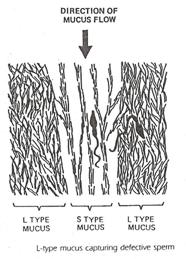A Note About S Mucus
S Mucus (oestrogenic)
S Mucus (Fig. 11-13) from the S crypts in the upper half of the cervix appears 1-3 days later then the L mucus. The higher levels of oestrogen stimulate its production. The S mucus is fluid and when it reaches the same amount as the L mucus, the woman notices a change in the character of mucus to a wet–slippery sensation at the vulva that remains until peak day. After one or two days, the oestrogen reaches a maximum level, as also does the S mucus.2 The S mucus transports and nourishes sperm. S mucus is very fluid and it forms swimming lanes in which sperm cells move along the cervical canal very rapidly, reaching the S crypts in the cervix in 3-10 minutes.3,7 Both L and S mucus cooperate to bring about an optimal sperm propagation to a crypt.
 The qualities of more-fertile mucus – clear, stretchy, spinnbarkeit, associated with a sensation of wetness, slipperiness or lubrication are due to the combined effects of L, S and P mucus. S mucus nourishes sperm in the crypts.1 Sperm can survive in the oestrogenic more-fertile mucus for up to five days.
The qualities of more-fertile mucus – clear, stretchy, spinnbarkeit, associated with a sensation of wetness, slipperiness or lubrication are due to the combined effects of L, S and P mucus. S mucus nourishes sperm in the crypts.1 Sperm can survive in the oestrogenic more-fertile mucus for up to five days.
<< Fig. 11-13; Structure of S Mucus: Diagram of sperm swimming up the cervical canal in the swimming lanes of S mucus. The L mucus acts as a filter for defective sperm.
S crypts and pre-menopause (ageing of the cervix):
The cervix ages naturally from birth to post-menopause. At puberty S crypts are very numerous but with increasing age L crypts replace S crypts.6 In the pre-menopause the decrease in number of S crypts results in a decrease in the number of days of more-fertile mucus. NOTE: When the cervix has aged, a woman may ovulate but yet produce no cervical mucus. Since the mucus is essential for sperm entry, even though the woman may have a biphasic temperature, such women are said to have non-fertile ovulations.1 Pregnancy stimulates the production of S crypts and rejuvenates the cervix by two to three years.6
S crypts and hormonal contraception (the ‘Pill’):
Oral contraceptives double the functional rate of aging of the cervix.6 “After three and up to fifteen months of contraceptive use, there is a greater loss of the S crypt cells than can be replaced”.5
References:
-
Klaus, Hanna; ‘Natural family planning – Is it scientific? Is it effective?’ see page 4, 13; Newman Lecture Series 1;May 21, 2000. ( online).
-
Odeblad Erik; ‘Investigations on the physiological basis for fertility awareness; Bulletin for the Ovulation Method Research and Reference Centre of Australia, vol 29, no 1, p2-11, march 2002, (internet, Billings Ovulation Method, www.woomb.org)
-
Odeblad, E; ‘The discovery of different types of cervical mucus and the Billings Ovulation Method’ page 10, 11, 14, 15, 18 ; Bulletin of the Ovulation Method Research and Reference Centre of Australia, Vol 21, No3; 3-35; Sept 1994. (google ‘Erik Odeblad, cervical mucus’.)
-
Odeblad E; ‘Some notes on the biology of the cervix’ 2007 (internet, google ‘Erik Odeblad, cervical mucus’)
-
Odeblad E; “Some notes on the cervical crypts”; Bulletin of the ovulation method Research and reference centre of Australia, vol 24 no 2 June 1997, p31.
-
Klaus, H ; Natural Family Planning : A Review 2nd Edition. July 1995, page 6; NFP Center of Washington, D.C. Inc. , 8514 Bradmoor Drive, Bethesda, MD 20817-3810
-
Fordney Settlage, Diane S, et al; ‘Sperm transport from the external cervical os to the fallopian tubes in women : A time and quantitation study’ Fertil and Steril; Vol 24, No 9, Sept 1973